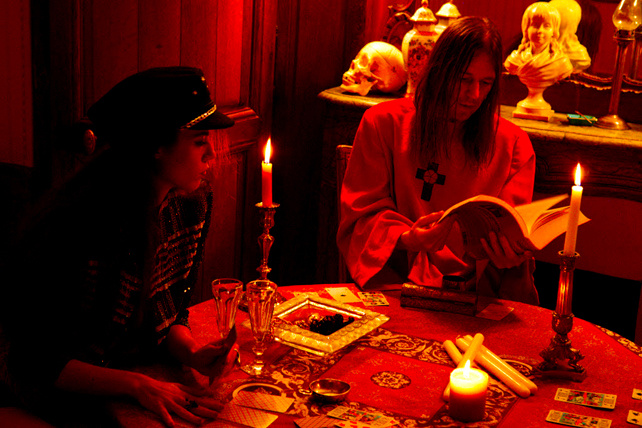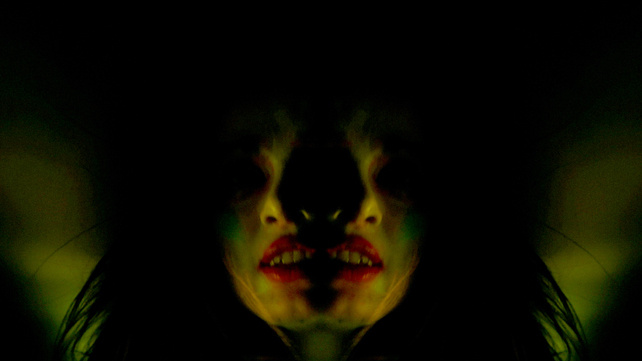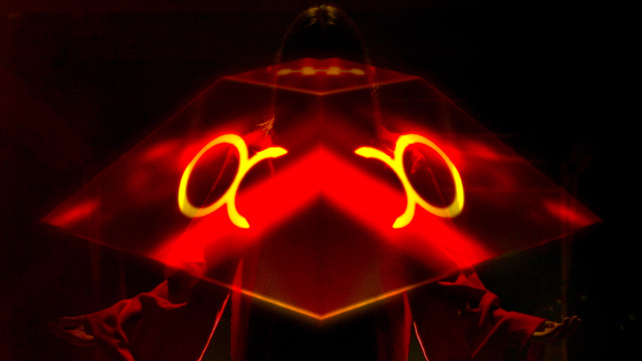Trailer forBabalon WorkingThursday night in LA Brian Butler will be premiering his new film, Babalon Working, at the Museum of Contemporary Art. The film, which features Paz de la Huerta undulating sensually amid what feels like the cinematic manifestation of a terrifying acid trip, is inspired by elements of Enochian magick. Developed by Edward Kelley and Dr. John Dee in the 1500s, Enochian magick was used in a series of rituals performed by Jack Parsons and L. Ron Hubbard popularly referred to as Babalon Working. The ceremonies produced what Parsons believed to be a conjuring of the “Scarlet Woman,” a figure whom Aleister Crowley had thought would help to bring about the Aeon of Horus and put an end to bepenised rulers and religions all over the world. Babalon Working was filmed in Prague, at Kelley’s home, lending the whole thing a feeling of intimacy and familiarity with its source of inspiration that it couldn’t have gotten had it been shot anywhere else.After the screening Brian will perform his new work, Transmigration, which will include fancy tools like an orgone generator and a violet ray machine. When speaking with Image Noir last week, Brian said that the performance will aim to “produce a state of mind which transcends the cycle of life and death.”I wanted to find out more about tonight’s screening and performance, so I called up Brian and Paz, who were kind enough to pull their car over to the side of the road and answer all of my questions. VICE: Brian, you’ve described your working process as being in a space between dreaming and awake. I was wondering if you could explain that a little more, and how you think one might get to that state.
VICE: Brian, you’ve described your working process as being in a space between dreaming and awake. I was wondering if you could explain that a little more, and how you think one might get to that state.
Brian: If you think of a triangle, it's the apex of the triangle, between polarities. It could be between life and death, for example. They call that the “hypnagogic state,” where you’re conscious enough to remain in control, but you're in a dream state where everything is fluid so that you can adjust things or go places. It's sort of like the astral plane, in a way. When I'm intensely involved in creating art or directing a film or whatever I’m doing, my ego kind of disappears and something else comes in and I’m only in that very immediate moment. I won't remember what I said ten seconds ago, for instance.
Paz: It’s the same way I work. Whenever I'm on a film set, in between takes or whatever, I'm always sleeping. The transition from sleeping to waking up is when I personally get in touch with my subconscious, which is where my creativity lies. We have different ways of explaining it, but that's when the best work comes out. I call it "let's get lost.”According to the press release, Babalon Working is trying to “explore the layers of ecstasy, madness, and creativity that mediate man’s voyage between life and death.” How much of a role do you think that stuff plays in our everyday lives?
Brian: As much as you can let it, you know? It's letting go, being free. You go back to someone like Antonin Artaud, who basically stated that anyone who lives the dream that they say they want is considered insane, you know? It's a certain freedom, and you're losing conditioning. You're going past the rational mind, as well as the environment and limitations around you. Everyone has a different way of reaching that. A lot of people do it naturally, or take drugs, or do occult, or yoga… there are a lot of ways to get there.
Paz: When I work, it's not the result; it's the process of being present and the journey. Like Brian said, he won't remember what he said ten seconds ago—I'm the same way. I'll memorize the script and know all my lines backward and forward and then I’ll forget them all. They're subconsciously there, however, and that let’s me be fully present so I can get lost and be in that space between asleep and awake. Still from Babalon WorkingTo me, the film seemed to lie somewhere between a retelling of the Parsons and Hubbard story, and also like maybe you were trying to perform parts of the ritual again. Is that right?
Still from Babalon WorkingTo me, the film seemed to lie somewhere between a retelling of the Parsons and Hubbard story, and also like maybe you were trying to perform parts of the ritual again. Is that right?
Brian: Well, it's more than that. It wasn't a reenactment at all, except for I was wearing the adeptus major’s robe of the AA, which is Aleister Crowley's order. But Enochian magick and Babalon Working precede Crowley and Parsons by hundreds of years. The Enochian Working happened in Prague in the 1500s. Parsons published his operation that he did with Hubbard; he's known for that, but it's a universal thing. Like the Isis Working, or Osiris. I was definitely influenced by those people and I know their work very well, but this was definitely my own personal vision and I was taking it a step further, going to the actual source of where it all started. It's not a documentary or biopic, it's a metaphorical, magickal, symbolist type of film in which everyone will get their own meaning.Do you think L. Ron Hubbard’s involvement with Babalon Working played any sort of role in his future life, and the course that it took?
Brian: Oh, absolutely. He actually learned a lot of secrets from Jack Parsons, and Parsons was in direct communication with Aleister Crowley. So they were doing these sorts of secret higher-level magick operations involving the Enochian system. So Hubbard picked up on some of these techniques and in some ways came out ahead of everyone—at least financially and fame-wise. [laughs] Parsons blew up in an accident, and Crowley died broke. What matters more? An eternal legacy? It's hard to judge what success or failure is, but definitely he was doing something correct, although people are very polarized about Hubbard and Scientology. Still from Babalon WorkingPaz, you’ve said that working on this film with Brian helped you recover from the accident you had while working on a film in Canada a few years ago. How so?
Still from Babalon WorkingPaz, you’ve said that working on this film with Brian helped you recover from the accident you had while working on a film in Canada a few years ago. How so?
Paz: I was in a Herculean battle for my life for nearly two years and it really got to the point where I needed to face whatever demons were inside of me that were preying on me. You can't run away from them, you have to face them head-on, so Brian helped me do that and to have some sort of exorcism—well, I wouldn’t even say “some sort of exorcism”—an exorcism, and I contribute it to saving my life.Was there one moment that was sort of an epiphany for you? Or was it just the whole experience of working with Brian?
Paz: I can't explain that, you know. There were inexplicable moments and I feel like going into them in too much depth would take away the positive power that they have in my life.
Brian: It's not really in words. To me, a real communication with an actor or performer is non-verbal. It's just being in sync and going to the same state.
Paz: I think we'll be working together until the end of time. Now that I feel like my body, the vessel of my soul, has been healed completely, we have a lot of work to do still—work that is eternal. Paz de la HuertaBrian, you have said that you think there's a connection between electricity and understanding the way death works. In Transmigration, the performance following the screening, you will be using things like an orgone generator, strobe lights, and sound waves. What are you hoping to achieve tonight?
Paz de la HuertaBrian, you have said that you think there's a connection between electricity and understanding the way death works. In Transmigration, the performance following the screening, you will be using things like an orgone generator, strobe lights, and sound waves. What are you hoping to achieve tonight?
Brian: In this particular performance I'm using more technology. It's less pagan than wearing a robe in the woods or something. I'm using certain concepts by Wilhelm Reich, like orgone energy, which is not necessarily electrical, but it's scientific—it's a way of harnessing energy. I’ll also be using some things that were invented by Tesla, like the violet ray machine. So it's kind of integrating technology and accessing these states, so an audience that may have no experience with this can be—with the right sound frequencies and the right light frequencies—transported temporarily to that same place. It's the same thing as the dream state between being awake and asleep. You can call it death, but it doesn't mean like dying by way of decay. It's more like death to your ego and everything you thought you were and just letting go and being in a state where you can transcend whatever limitations you thought existed.You're going to have an orgone generator too, right? Can you explain how those things work? It collects orgone energy and lets you direct it at stuff?
Brian: Yeah. I'm developing a device because orgone energy is by nature inductive, so it attracts energy. An orgone accumulator box is a device where someone sits and it accumulates the energy—it goes inside. So I'm kind of reversing the polarity where I'm projecting this orgone force out into the room so that the whole room becomes an orgone chamber. Still from Babalon WorkingDoes it have a physical effect on the audience or the people in the room?
Still from Babalon WorkingDoes it have a physical effect on the audience or the people in the room?
Brian: I would hope so. Yeah, it should have a positive effect. Orgone energy is basically the energy of life, or chi… there are lots of different names for it. The fire, the creativity, the spark… the energy of life, you know?You can RSVP here for tonight's screening and performance. Doors open at 7:00 PM PST and the film will begin at 8:00. If you aren't in LA tonight, Babalon Working will be featured on MoCA's website beginning tomorrow.@Jonathan_Smth
Advertisement

Brian: If you think of a triangle, it's the apex of the triangle, between polarities. It could be between life and death, for example. They call that the “hypnagogic state,” where you’re conscious enough to remain in control, but you're in a dream state where everything is fluid so that you can adjust things or go places. It's sort of like the astral plane, in a way. When I'm intensely involved in creating art or directing a film or whatever I’m doing, my ego kind of disappears and something else comes in and I’m only in that very immediate moment. I won't remember what I said ten seconds ago, for instance.
Paz: It’s the same way I work. Whenever I'm on a film set, in between takes or whatever, I'm always sleeping. The transition from sleeping to waking up is when I personally get in touch with my subconscious, which is where my creativity lies. We have different ways of explaining it, but that's when the best work comes out. I call it "let's get lost.”
Advertisement
Brian: As much as you can let it, you know? It's letting go, being free. You go back to someone like Antonin Artaud, who basically stated that anyone who lives the dream that they say they want is considered insane, you know? It's a certain freedom, and you're losing conditioning. You're going past the rational mind, as well as the environment and limitations around you. Everyone has a different way of reaching that. A lot of people do it naturally, or take drugs, or do occult, or yoga… there are a lot of ways to get there.
Paz: When I work, it's not the result; it's the process of being present and the journey. Like Brian said, he won't remember what he said ten seconds ago—I'm the same way. I'll memorize the script and know all my lines backward and forward and then I’ll forget them all. They're subconsciously there, however, and that let’s me be fully present so I can get lost and be in that space between asleep and awake.

Brian: Well, it's more than that. It wasn't a reenactment at all, except for I was wearing the adeptus major’s robe of the AA, which is Aleister Crowley's order. But Enochian magick and Babalon Working precede Crowley and Parsons by hundreds of years. The Enochian Working happened in Prague in the 1500s. Parsons published his operation that he did with Hubbard; he's known for that, but it's a universal thing. Like the Isis Working, or Osiris. I was definitely influenced by those people and I know their work very well, but this was definitely my own personal vision and I was taking it a step further, going to the actual source of where it all started. It's not a documentary or biopic, it's a metaphorical, magickal, symbolist type of film in which everyone will get their own meaning.
Advertisement
Brian: Oh, absolutely. He actually learned a lot of secrets from Jack Parsons, and Parsons was in direct communication with Aleister Crowley. So they were doing these sorts of secret higher-level magick operations involving the Enochian system. So Hubbard picked up on some of these techniques and in some ways came out ahead of everyone—at least financially and fame-wise. [laughs] Parsons blew up in an accident, and Crowley died broke. What matters more? An eternal legacy? It's hard to judge what success or failure is, but definitely he was doing something correct, although people are very polarized about Hubbard and Scientology.

Paz: I was in a Herculean battle for my life for nearly two years and it really got to the point where I needed to face whatever demons were inside of me that were preying on me. You can't run away from them, you have to face them head-on, so Brian helped me do that and to have some sort of exorcism—well, I wouldn’t even say “some sort of exorcism”—an exorcism, and I contribute it to saving my life.Was there one moment that was sort of an epiphany for you? Or was it just the whole experience of working with Brian?
Paz: I can't explain that, you know. There were inexplicable moments and I feel like going into them in too much depth would take away the positive power that they have in my life.
Brian: It's not really in words. To me, a real communication with an actor or performer is non-verbal. It's just being in sync and going to the same state.
Paz: I think we'll be working together until the end of time. Now that I feel like my body, the vessel of my soul, has been healed completely, we have a lot of work to do still—work that is eternal.
Advertisement

Brian: In this particular performance I'm using more technology. It's less pagan than wearing a robe in the woods or something. I'm using certain concepts by Wilhelm Reich, like orgone energy, which is not necessarily electrical, but it's scientific—it's a way of harnessing energy. I’ll also be using some things that were invented by Tesla, like the violet ray machine. So it's kind of integrating technology and accessing these states, so an audience that may have no experience with this can be—with the right sound frequencies and the right light frequencies—transported temporarily to that same place. It's the same thing as the dream state between being awake and asleep. You can call it death, but it doesn't mean like dying by way of decay. It's more like death to your ego and everything you thought you were and just letting go and being in a state where you can transcend whatever limitations you thought existed.You're going to have an orgone generator too, right? Can you explain how those things work? It collects orgone energy and lets you direct it at stuff?
Brian: Yeah. I'm developing a device because orgone energy is by nature inductive, so it attracts energy. An orgone accumulator box is a device where someone sits and it accumulates the energy—it goes inside. So I'm kind of reversing the polarity where I'm projecting this orgone force out into the room so that the whole room becomes an orgone chamber.
Advertisement

Brian: I would hope so. Yeah, it should have a positive effect. Orgone energy is basically the energy of life, or chi… there are lots of different names for it. The fire, the creativity, the spark… the energy of life, you know?You can RSVP here for tonight's screening and performance. Doors open at 7:00 PM PST and the film will begin at 8:00. If you aren't in LA tonight, Babalon Working will be featured on MoCA's website beginning tomorrow.@Jonathan_Smth
